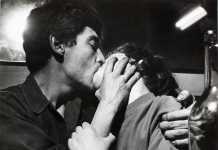

A comprehensive retrospective of works by the American photographer Walker Evans (1903-1975) is on view at the Centre Pompidou in Paris until August 14, 2017. The exhibition, curated by Clément Chéroux and Julie Jones, focuses on Walker Evans’ reality-based documentation of the ordinary and the vernacular with his straightforward black-and-white photographs. The show stems from a partnership between Centre Pompidou and Terra Foundation, an institution dedicated to promoting the exploration and understanding of visual arts in the United States.
Walker Evans is best known for his post-depression era photographs of tenant farmers and their families in Alabama. These photographs were published in the 1941 book ‘Let Us Now Praise Famous Men’, which he co-authored with James Agee. They include the well-known poignant portrait of Allie Mae Burroughs that became iconic of the Depression-era United States. Centre Pompidou’s exhibition Walker Evans shows a sizeable selection of these photographs, as well as those that Evans took in the 1930s while on assignment for the Farm Security Administration (FSA). These include his documentation of the racial segregation, food queues and despair in the makeshift camps set up for those affected by the disastrous 1937 Mississippi river floods.

These photographs feature along with other themes that Evans explored during his career, thus providing a comprehensive and alternative overview of Evans’ style, his manner of working and his relentless quest to photograph what he saw, as he saw it. His simple, neatly composed and honest photographs are an ode to the mundane details of everyday life and to the beauty of what is ordinary and lost.

The retrospective assembles more than 300 vintage prints and 100 documents along with Walker Evans’s personal collection of postcards, enamel plaques, cut-outs and graphic ephemera. Some highlights include three photographic series by Walker Evans where he documented the anonymous passersby and pedestrians in the streets of Bridgeport, Detroit and Chicago, as well as his clandestine images of commuters taken in the New York subway.

Evans’s photographs also preserve the memories of a changing America and its people. On show are Evans’s photographs of shopfront displays, roadside stalls, ingeniously-built rural churches as well as his constant documentation of street signs, advertisements and movie posters. Some of these photographs were published in the Fortune Magazine in the 1940s and 1950s, most of them accompanied by Evans’s subtly ironic style of writing.

The exhibition also shows some rarely-seen self-portraits and photographs of close friends and family, including Berenice Abbott, Lincoln Kirstein, and his wife Jeanne Ninas. His clean, non-mainstream approach to photography is once again evident in his simple but elegant photographs of everyday objects and tools, such as those that featured in his photographic essay ‘The Beauties of the Common Tool’ published in the Fortune Magazine in July 1955.

These photographs are, first and foremost, a documentation of everyday moments, commonplace things, found objects and regular people. They also run counter to the mainstream ideas of beauty and aesthetics. All the ‘ordinary’ and the ‘vernacular’ that Evans records in his images and the manner in which he shows us the plainness of life is perhaps what makes these photographs so powerful.
The exhibition Walker Evans is on view at the Centre Pompidou, Paris until August 14, 2017, and will subsequently travel to San Francisco Museum of Modern Art (September 30, 2017 – February 4, 2018).
Buy the official catalogue of the Walker Evans exhibition or Walker Evans’s American Photographs published by MoMA.
April 26, 2017 to August 14, 2017
At Centre Pompidou

Walker Evans
Centre Pompidou, Paris presents a comprehensive exhibition of works by American photographer Walker Evans, perhaps best-known for his photographs of Alabama tenant farmers and their families. The show brings together a selection of over 300 photographs from private and public collections to shed new light on Walker Evans’s documentary-style of taking reality-based images.









